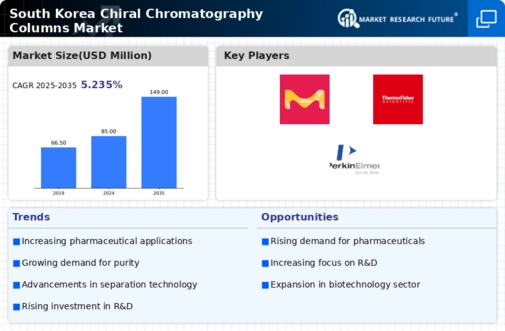Emergence of New Applications
The emergence of new applications for chiral chromatography-columns is contributing to the market's growth in South Korea. Industries such as agrochemicals and environmental testing are increasingly recognizing the importance of chiral separation techniques. For instance, the need to analyze chiral pesticides and assess their environmental impact is becoming more pronounced. This diversification of applications is likely to expand the customer base for chiral chromatography-columns, thereby driving market growth. As industries evolve and new regulatory requirements emerge, the chiral chromatography-columns market is positioned to adapt and thrive, suggesting a promising outlook for stakeholders in South Korea.
Growth in Biotechnology Research
Biotechnology research in South Korea is rapidly advancing, leading to an increased requirement for chiral chromatography-columns. These columns are essential for the analysis and purification of chiral compounds, which are pivotal in biopharmaceutical development. The South Korean biotechnology sector is projected to grow at a CAGR of around 10% in the coming years, driven by government initiatives and private investments. This growth is likely to enhance the demand for chiral chromatography-columns, as researchers seek efficient methods for separating and analyzing complex biological mixtures. The expansion of biotechnology research thus serves as a critical driver for the chiral chromatography-columns market, reflecting the evolving landscape of scientific inquiry and innovation.
Increased Focus on Quality Control
Quality control measures in various industries, particularly in pharmaceuticals and food production, are becoming increasingly stringent in South Korea. This heightened focus necessitates the use of advanced analytical techniques, including chiral chromatography-columns, to ensure compliance with regulatory standards. The chiral chromatography-columns market is likely to benefit from this trend, as companies invest in reliable separation technologies to maintain product integrity. With the South Korean government emphasizing quality assurance in manufacturing processes, the demand for chiral chromatography-columns is expected to rise significantly. This driver indicates a shift towards more rigorous quality control practices, which could potentially reshape the landscape of the chiral chromatography-columns market.
Rising Demand in Pharmaceutical Sector
The pharmaceutical sector in South Korea is experiencing a notable increase in demand for chiral chromatography-columns. This growth is primarily driven by the need for precise separation of enantiomers in drug development and quality control processes. As the industry continues to expand, the Chiral Chromatography Columns Market is projected to witness a compound annual growth rate (CAGR) of approximately 8% over the next five years. The increasing focus on personalized medicine further amplifies the need for these columns, as they play a crucial role in ensuring the efficacy and safety of chiral drugs. Consequently, the rising demand in the pharmaceutical sector is a significant driver for the chiral chromatography-columns market, indicating a robust future for this segment in South Korea.
Technological Innovations in Column Design
Technological innovations in the design and manufacturing of chiral chromatography-columns are playing a pivotal role in enhancing market dynamics in South Korea. Advances such as the development of more efficient stationary phases and improved column packing techniques are enabling higher resolution and faster separations. These innovations are likely to attract a broader range of users, from academic researchers to industrial laboratories, thereby expanding the market. The chiral chromatography-columns market is expected to benefit from these advancements, as they not only improve performance but also reduce operational costs. This driver highlights the importance of continuous innovation in maintaining competitiveness within the chiral chromatography-columns market.














Leave a Comment